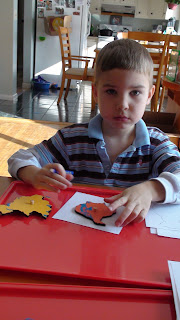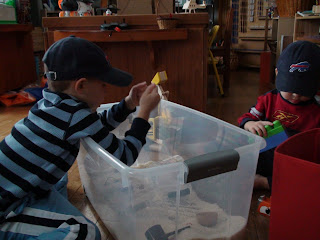
These are the Montessori sandpapper letters. In Montessori, all 5 senses are used to learn all academic subjects. Sandpaper letters are used to engage the child's tactile senses to help the child associate the sounds of speech with there written symbols. This process forms the first preperation, not only for writting but for reading. As the child traces the letter, the child says the sound of the letter. Sandpapper letters are used in teaching print, and cursive.

Children at this age are very sensorial, or sense oriented. They love to move, touch, feel, and manipulate. This is a natural sensitive period for this age. The Montessori materials have this sensorial aspect integrated into each material.
What an amazing day, when the child himself realizes he can write. Without even knowing, he was being prepared for all the necessary movements for writting. As Maria Montessori states, "But the day will come when he will write, and that will be a day of great surprise for him, the wonderful harvest of an unknown sowing". How beautiful that the learning of a child is not forced, or placed upon him but naturally unviels itself as the child perfects himself in each activity.
The age for the sandpaper letters is 3-6 years of age. Christian is 6 years old. He is already writing and reading. He still loves to do the sandpaper letters. This work is out for his younger brother, Joshua to do. Christian had 1 year of formal Montessori education by a certified Montessori instructor.
Although, I have read alot of Maria Montessori's books and I have the Montessori curriculum and all the materials. I am not certified in the Montessori philosophy or use of the materials. I have defiantly made mistakes. As soon, or maybe before I give birth I would like to get my Montessori certification.
I learned something very interesting today about the importance of preperation in the Montessori approach as I was observing Joshua. I put the sandpaper letters out for Joshua, but I noticed he was having a very hard time following the lines of the letters. It was a great struggle. Christian at this age had no problems with this. So, why was Joshua having such a hard time . . . .
Answer - lack of preparation. Christian was prepared for this work, Joshua was not. Joshua is not adequately trained in the tactile, 2 finger approach with the other materials and does not have enough practice of following the curves of objects. There is a whole suite of other materials that use this 2 finger touch approach to work. The knobbed cylinders, the metal insets, the touch boards to name a few. These materials are very easy for the child to follow with the 2 finger approach and completely prepares them for following the complexity of the letter symbols.
(Side note - the 2 finger approach is using the first 2 fingers to touch. The use of 2 fingers increases the tactlie sensation.)
Remember, Montessori materials are designed to work off of eachother in a orderly manner. They all lead to success in the next material, when each material has been successfully mastered. If you rush to the next work or the child has not mastered the previous material, this sets them up for failure in the next work. Maria Montessori's philosophy is rooted in proper preparation which puts the child in position to experience success.
My mistakes - First, I taught the knobbed cylinders work without having Joshua use the 2 finger touch around each cylinder. I made this mistake in a few other works as well. On a good note, he is still in the sensorial stage. He still has natural motivation towards these materials. I will go back and re-model the materials the proper way, with the 2 finger touch. He will self-correct himself. This will give Joshua's fingers the practice of following curves of different shapes. Now, when we go back to the sandpaper letters, his fingers will have the proper strengthening and the control to follow the complexities of the letter symbols.
You see, When I introduced Joshua to the sandpaper letters work, it was way to difficult for him to do. It was confusing for his mind, he had to concentrate on too many new things. He had to work to get control of his fingers and work to follow the lines of the letters.
When Joshua has strengthened his 2 finger touch and has had many experiences of following the curves and lines of different objects, the sandpaper letters will be much easier to do. His fingers will be adequately prepared for the complexities of following the letter symbols and will be able to imitate with ease and pleasure.
Something to think about . . . . the importance of remote motor preparation for writing and to realize the immense strain which we impose upon children, when we set them to write directly without a previous motor education of the hand!
I talk to many kindergarten and early elementary teachers in the traditional model of education. I find that most of the teachers find there kindergartners not prepared for writing. They come from home, or preschool into kindergarten and there little hands are not prepared for the rigors of handwriting. Traditional schools have no motor preparation designed to strengthen there fingers. There fingers are tired. Handwriting becomes a tedious chore. Handwriting suffers in quality because there little hands are not prepared for this work. To make matters worse, generally speaking, by the time children at age 6 are going into kindergarten, they have already passed there sensitive period for writing. So, learning how to write is not something they are internally motivated to practice. It is the diffrence between work being enjoyable and work being cumbersome.
If at all possible, the goal is to present learning concepts to children when they have a natural inclination and motivation to learn. Maria Montessori refers to this natural inclination as the "sensitive periods of learning". When work is iniated by the child, great learning is possible. Learning is not experienced as a tedious chore but a grand adventure!










.jpg)








































